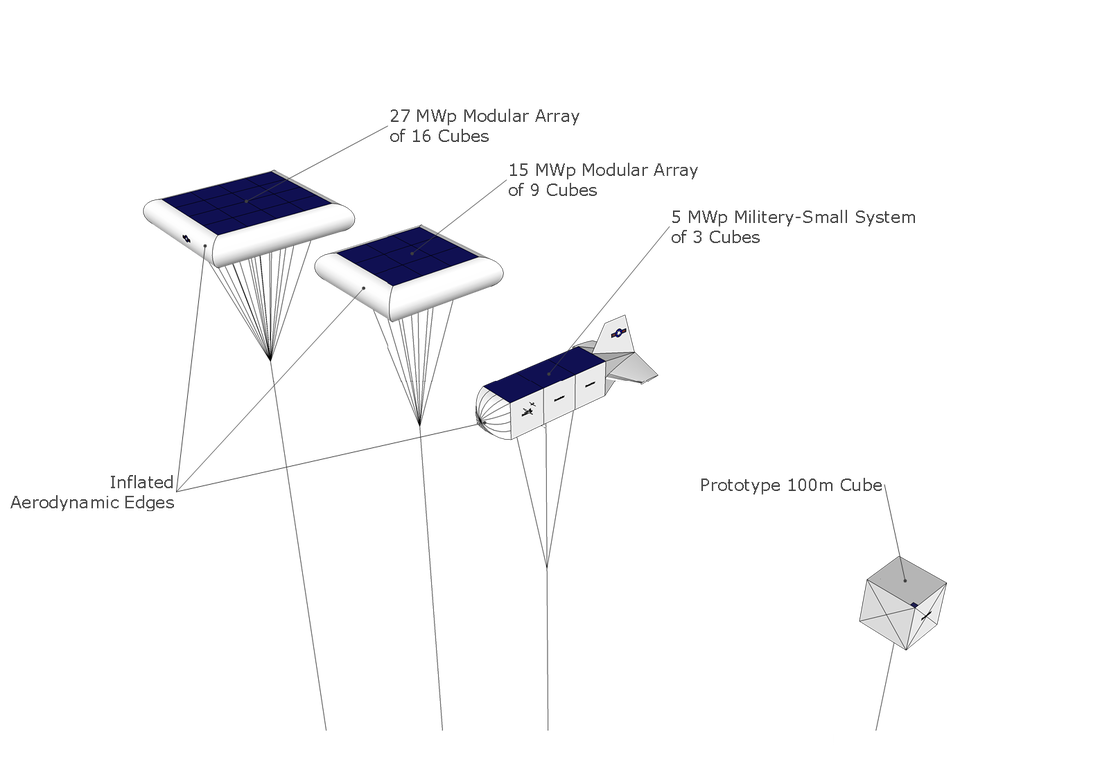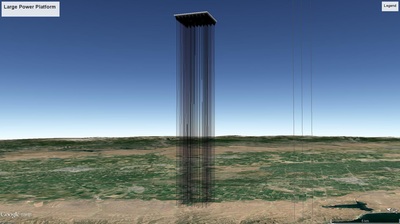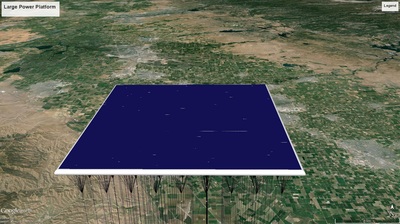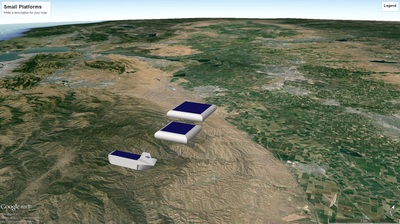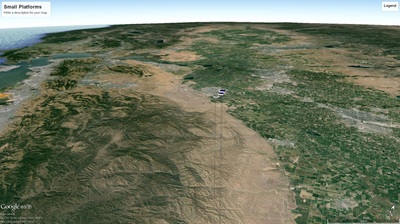PV Generation Platforms
The key enabling insights set the design parameters for possible engineering solutions. StratoSolar has created a detailed engineering design for a particular solution and is developing that solution. The following is a high level description.
StratoSolar PV power plants are constructed from buoyant, rigid, platforms that support large arrays of photovoltaic (PV) panels on their top surface. They float stationary in the low stratosphere at 20 kilometer (km) altitude (65,616 feet) for the thirty year life of the power plants. They are connected to the ground and held in place with strong and light Kevlar or UHMPE tethers. The tethers also support High Voltage (HV) power lines that transfer the electric power generated by the PV panels to the ground. Excess buoyancy in the floating platforms pre-tension the tethers and allow the platform to resist wind forces with small horizontal deflections. The pictures below show the size of a range of power plants from 5 Mega Watts rated power (MWp) to 10.3 Giga Watts rated power (GWp ). Because of their large horizontal dimensions the platforms appear as flat and thin, but they are actually about 100m deep. As can be seen, there are many redundant tethers connecting the large platforms to the ground.The pictures exaggerate the visibility of the tethers which are only a few cm in diameter.
StratoSolar PV power plants are constructed from buoyant, rigid, platforms that support large arrays of photovoltaic (PV) panels on their top surface. They float stationary in the low stratosphere at 20 kilometer (km) altitude (65,616 feet) for the thirty year life of the power plants. They are connected to the ground and held in place with strong and light Kevlar or UHMPE tethers. The tethers also support High Voltage (HV) power lines that transfer the electric power generated by the PV panels to the ground. Excess buoyancy in the floating platforms pre-tension the tethers and allow the platform to resist wind forces with small horizontal deflections. The pictures below show the size of a range of power plants from 5 Mega Watts rated power (MWp) to 10.3 Giga Watts rated power (GWp ). Because of their large horizontal dimensions the platforms appear as flat and thin, but they are actually about 100m deep. As can be seen, there are many redundant tethers connecting the large platforms to the ground.The pictures exaggerate the visibility of the tethers which are only a few cm in diameter.
The platforms at 20 km altitude are rigid, aluminum truss, structures that support the PV panel array on their top surface. The buoyancy comes from very large volume (approximately 1,000,000 m3), thin-plastic-film, zero-pressure gasbags, filled with helium or hydrogen and contained by netting within the large empty spaces within the truss framework. While the buoyant structures are novel, there is no new science or exotic materials used in their construction. A combination of accurate structural analysis and reliable meteorological data provide high confidence in structural integrity under worst case weather conditions including hurricanes and tornadoes. Accurate climate models for sunlight and how it varies with location and altitude, daily and seasonally, provide an equally high confidence level for the electrical power output.
The large kilometer-scale systems are a collection of mechanically connected, individual, modular small-100 m-scale systems. The small modular systems are raised to 20 km (65,000 feet) individually and connected together into large arrays at 20 km altitude. The tethers will have less visual impact than shown, though lights and other visibility enhancements will be required by airspace regulators. The benefits of connecting multiple small-scale systems to make a larger system are, reduced aerodynamic drag on the platform and the reduced impact of fewer large systems on regulated airspace. The reduced aerodynamic drag ensures that the structure can withstand the highest wind forces with a large safety margin and is safe to deploy on a permanent basis. It also facilitates construction, modular maintenance and repair, technology upgrades, and incremental overall system expansion. Individual small arrays can be winched down in a few hours when weather permits and can use adjacent tethers as guides to ensure safe control.
Operationally there is no need for people at 20 km. Also, there is no need for large “hanger” structures on the ground, either for construction or maintenance. Maintenance on the ground only occurs during good weather and at night to avoid disruption in power output.
The large kilometer-scale systems are a collection of mechanically connected, individual, modular small-100 m-scale systems. The small modular systems are raised to 20 km (65,000 feet) individually and connected together into large arrays at 20 km altitude. The tethers will have less visual impact than shown, though lights and other visibility enhancements will be required by airspace regulators. The benefits of connecting multiple small-scale systems to make a larger system are, reduced aerodynamic drag on the platform and the reduced impact of fewer large systems on regulated airspace. The reduced aerodynamic drag ensures that the structure can withstand the highest wind forces with a large safety margin and is safe to deploy on a permanent basis. It also facilitates construction, modular maintenance and repair, technology upgrades, and incremental overall system expansion. Individual small arrays can be winched down in a few hours when weather permits and can use adjacent tethers as guides to ensure safe control.
Operationally there is no need for people at 20 km. Also, there is no need for large “hanger” structures on the ground, either for construction or maintenance. Maintenance on the ground only occurs during good weather and at night to avoid disruption in power output.
Various views of a large and some small PV generation platforms
Illustrative practical example: San Francisco Bay Area
This image is particularly informative in illustrating several practical aspects of the power platform.
The picture looks out due west across the Pacific from a viewpoint slightly above 20km altitude. It shows the curvature of the earth in the distance out over the ocean and the built up area around San Francisco Bay along with the StratoSolar platform. Clicking on the image gets a high resolution picture.
The platform shown has a nameplate capacity of about 4GW and an average electricity output of about 2GW, enough to supply most of the current electricity demand for the light grey populated area shown. Also visible in the picture are the weights suspended from the platform used to store gravity energy. These are the small barely visible disks on the tethers just beneath the platform. This energy storage makes the platform a complete direct replacement for dispatchable fossil fuel plants.
The platform is located over unpopulated land about 75km from the built up area. It is also located away from flight corridors.
A platform this size could be operational by 2025 providing electricity for $0.015/kWh to $0.04/kWh based upon 2021 PV prices. It would start small with one 27 MW element and grow incrementally over time with additional 27 MW units. It has considerable potential to grow larger and ultimately supply more than 40 GW of electricity by 2050. Cost will come down over this time frame with volume production and this will result in even cheaper electricity that could be used to make affordable synthetic fuels.
The picture looks out due west across the Pacific from a viewpoint slightly above 20km altitude. It shows the curvature of the earth in the distance out over the ocean and the built up area around San Francisco Bay along with the StratoSolar platform. Clicking on the image gets a high resolution picture.
The platform shown has a nameplate capacity of about 4GW and an average electricity output of about 2GW, enough to supply most of the current electricity demand for the light grey populated area shown. Also visible in the picture are the weights suspended from the platform used to store gravity energy. These are the small barely visible disks on the tethers just beneath the platform. This energy storage makes the platform a complete direct replacement for dispatchable fossil fuel plants.
The platform is located over unpopulated land about 75km from the built up area. It is also located away from flight corridors.
A platform this size could be operational by 2025 providing electricity for $0.015/kWh to $0.04/kWh based upon 2021 PV prices. It would start small with one 27 MW element and grow incrementally over time with additional 27 MW units. It has considerable potential to grow larger and ultimately supply more than 40 GW of electricity by 2050. Cost will come down over this time frame with volume production and this will result in even cheaper electricity that could be used to make affordable synthetic fuels.


